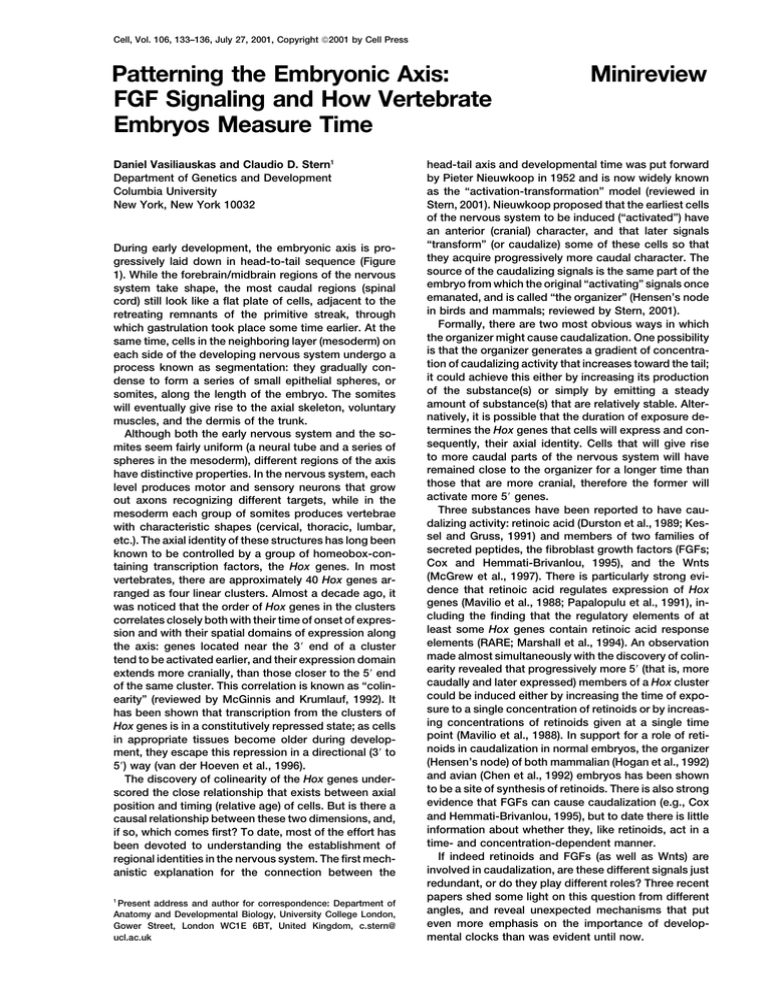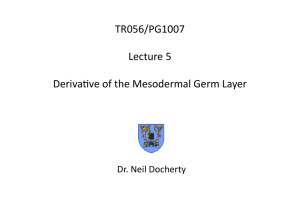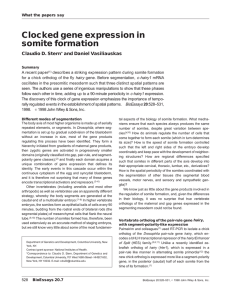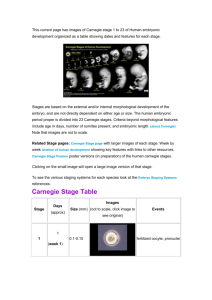Minireview Patterning the Embryonic Axis: FGF Signaling and How Vertebrate Embryos Measure Time
advertisement

Cell, Vol. 106, 133–136, July 27, 2001, Copyright 2001 by Cell Press Patterning the Embryonic Axis: FGF Signaling and How Vertebrate Embryos Measure Time Daniel Vasiliauskas and Claudio D. Stern1 Department of Genetics and Development Columbia University New York, New York 10032 During early development, the embryonic axis is progressively laid down in head-to-tail sequence (Figure 1). While the forebrain/midbrain regions of the nervous system take shape, the most caudal regions (spinal cord) still look like a flat plate of cells, adjacent to the retreating remnants of the primitive streak, through which gastrulation took place some time earlier. At the same time, cells in the neighboring layer (mesoderm) on each side of the developing nervous system undergo a process known as segmentation: they gradually condense to form a series of small epithelial spheres, or somites, along the length of the embryo. The somites will eventually give rise to the axial skeleton, voluntary muscles, and the dermis of the trunk. Although both the early nervous system and the somites seem fairly uniform (a neural tube and a series of spheres in the mesoderm), different regions of the axis have distinctive properties. In the nervous system, each level produces motor and sensory neurons that grow out axons recognizing different targets, while in the mesoderm each group of somites produces vertebrae with characteristic shapes (cervical, thoracic, lumbar, etc.). The axial identity of these structures has long been known to be controlled by a group of homeobox-containing transcription factors, the Hox genes. In most vertebrates, there are approximately 40 Hox genes arranged as four linear clusters. Almost a decade ago, it was noticed that the order of Hox genes in the clusters correlates closely both with their time of onset of expression and with their spatial domains of expression along the axis: genes located near the 3⬘ end of a cluster tend to be activated earlier, and their expression domain extends more cranially, than those closer to the 5⬘ end of the same cluster. This correlation is known as “colinearity” (reviewed by McGinnis and Krumlauf, 1992). It has been shown that transcription from the clusters of Hox genes is in a constitutively repressed state; as cells in appropriate tissues become older during development, they escape this repression in a directional (3⬘ to 5⬘) way (van der Hoeven et al., 1996). The discovery of colinearity of the Hox genes underscored the close relationship that exists between axial position and timing (relative age) of cells. But is there a causal relationship between these two dimensions, and, if so, which comes first? To date, most of the effort has been devoted to understanding the establishment of regional identities in the nervous system. The first mechanistic explanation for the connection between the 1 Present address and author for correspondence: Department of Anatomy and Developmental Biology, University College London, Gower Street, London WC1E 6BT, United Kingdom, c.stern@ ucl.ac.uk Minireview head-tail axis and developmental time was put forward by Pieter Nieuwkoop in 1952 and is now widely known as the “activation-transformation” model (reviewed in Stern, 2001). Nieuwkoop proposed that the earliest cells of the nervous system to be induced (“activated”) have an anterior (cranial) character, and that later signals “transform” (or caudalize) some of these cells so that they acquire progressively more caudal character. The source of the caudalizing signals is the same part of the embryo from which the original “activating” signals once emanated, and is called “the organizer” (Hensen’s node in birds and mammals; reviewed by Stern, 2001). Formally, there are two most obvious ways in which the organizer might cause caudalization. One possibility is that the organizer generates a gradient of concentration of caudalizing activity that increases toward the tail; it could achieve this either by increasing its production of the substance(s) or simply by emitting a steady amount of substance(s) that are relatively stable. Alternatively, it is possible that the duration of exposure determines the Hox genes that cells will express and consequently, their axial identity. Cells that will give rise to more caudal parts of the nervous system will have remained close to the organizer for a longer time than those that are more cranial, therefore the former will activate more 5⬘ genes. Three substances have been reported to have caudalizing activity: retinoic acid (Durston et al., 1989; Kessel and Gruss, 1991) and members of two families of secreted peptides, the fibroblast growth factors (FGFs; Cox and Hemmati-Brivanlou, 1995), and the Wnts (McGrew et al., 1997). There is particularly strong evidence that retinoic acid regulates expression of Hox genes (Mavilio et al., 1988; Papalopulu et al., 1991), including the finding that the regulatory elements of at least some Hox genes contain retinoic acid response elements (RARE; Marshall et al., 1994). An observation made almost simultaneously with the discovery of colinearity revealed that progressively more 5⬘ (that is, more caudally and later expressed) members of a Hox cluster could be induced either by increasing the time of exposure to a single concentration of retinoids or by increasing concentrations of retinoids given at a single time point (Mavilio et al., 1988). In support for a role of retinoids in caudalization in normal embryos, the organizer (Hensen’s node) of both mammalian (Hogan et al., 1992) and avian (Chen et al., 1992) embryos has been shown to be a site of synthesis of retinoids. There is also strong evidence that FGFs can cause caudalization (e.g., Cox and Hemmati-Brivanlou, 1995), but to date there is little information about whether they, like retinoids, act in a time- and concentration-dependent manner. If indeed retinoids and FGFs (as well as Wnts) are involved in caudalization, are these different signals just redundant, or do they play different roles? Three recent papers shed some light on this question from different angles, and reveal unexpected mechanisms that put even more emphasis on the importance of developmental clocks than was evident until now. Cell 134 Figure 1. Chick Embryo at the 10-Somite Stage The tail end of the embryo contains cells that are relatively younger than more cranial regions in both the nervous system and the mesoderm. NP, neural plate; som, somites; SP, segmental plate (presomitic mesoderm). FGF Signaling and Patterning of the Nervous System In one set of experiments, Mathis et al. (2001) start by analyzing how the most caudal part of the neural plate (which lies adjacent to Hensen’s node at the stage when the embryo has only a few somites) gradually contributes to the elongating neural plate. Is this a special region containing a resident population of asymmetrically dividing stem cells, whose descendants gradually populate the elongating spinal cord but the parent cells remain within, or do cells constantly transit through it? Mathis et al. (2001) reveal that neither is an accurate view. The caudal primordium of the neural plate does indeed contain cells that divide relatively rapidly and maintains itself as a growth region (therefore the region as a whole has “stem cell” status), but these cells do not contribute to the spinal cord by asymmetric division—instead, the expanding population is spread out along the neural tube by cell movements of convergence and extension. As cells are driven out of the growth region, they change their pattern of movement, which gradually becomes more and more restricted in space. Strikingly, misexpression of a dominant-negative FGF receptor construct in this tissue causes cells prematurely to leave the stem cell region and to change their pattern of movements as if they had aged. The authors therefore propose that signaling through the FGF receptor is required for the maintenance of the stem cell status in the caudal neural plate. Importantly, they raise the attractive possibility that FGF acts as a caudalizing factor for the neural tube because it prolongs the window of time during which cells are exposed to a caudalizing factor, which is something other than FGF (for example, retinoic acid). Hox Genes, FGF Signaling, and Patterning of the Mesoderm Two papers in this issue of Cell provide independent support for this general idea, this time for the somite mesoderm. Some years ago, it was shown in chick embryos that before somite formation, presomite cells (the “segmental plates”) experience repeated bursts of expression of the Hairy/Enhancer of split-related gene hairy1, with a frequency similar to that of somite formation. Several other genes (including a second Hairy gene, hairy2, and a glycosyltransferase that modulates Notch signaling, Lunatic Fringe, or LFng) have since been found to cycle with a similar period (reviewed by Dale and Pourquié, 2000). The cyclic activation of these genes has been said to reflect the action of a “segmentation clock” that regulates the timing of segmentation. Now, in the chick embryo, Dubrulle et al. (2001 [this issue of Cell]) start from the observation that FGF8 is expressed only in the caudal (youngest) part of the segmental plate. Surgical rotations of cells in different parts of the segmental plate show a correlation of the FGF8-expressing region with the ability of cells to “regulate” (that is, to compensate for the surgery and develop as dictated by their new position). Cells in the FGF-expressing caudal part of the segmental plate regulate, while cells outside this region cannot. When FGF8 is ectopically expressed throughout the presomitic mesoderm, cells stay unsegmented, express early presomitic markers, and fail to express markers of more mature somite derivatives, as if they had been forced to remain forever young. By contrast, local application of a bead soaked in FGF8 causes several abnormally small somites to form ahead of the bead, then a larger somite behind the bead, and then normal somites (see also below). Because of the formation of smaller somites ahead of the bead, one additional somite tends to develop within the same space, from about the same number of precursor cells. This finding suggests that FGF8 might cause some presomite cells to experience an additional oscillation of the “clock” before becoming committed to segment. Does the additional oscillation affect axial identity? Indeed, Dubrulle et al. (2001) find a cranial shift of one somite length in the boundary of expression of two Hox genes, Hoxb9 and Hoxa10 (whose normal expression limits are close to where the bead was placed). The remaining paper gives insight into how the segmentation clock and positional identity may be connected. Zákány et al. (2001 [this issue of Cell]) examine the expression of Hox genes in the mesoderm that emerges from the remnants of the primitive streak to form the presomitic mesoderm in the mouse. They find that the formation of each somite is immediately preceded by a burst of transcriptional activation of at least four of the Hox genes (Hoxd1, Hoxd3, Hoxa1, and Hoxb1) in the whole of the next prospective somite, followed by rapid downregulation in the caudal part of that prospective somite, and finally by complete disappearance of the transcripts as the new somite forms. Careful comparative analysis of the expression of Hoxd1, LFng, and another gene encoding a component of the Notch pathway, Mesp2, led the authors to conclude that the most Minireview 135 cranial presomite (“somite ⫺I”) starts out with high levels of LFng, followed by high levels of Mesp2, then by high levels of Hoxd1, and finally Hoxd1 is downregulated, starting in the posterior part of that presomite just before it splits off from the segmental plate. Zákány et al. (2001) investigated whether these bursts of Hox transcription are up- or downstream of the segmentation clock by analyzing embryos with a mutation for the Notch pathway component RBPJ() (a mouse homolog of Su(H) of Drosophila), which fails to make somites. They report that Hoxd1 transcription is severely reduced in the presomitic mesoderm of the mutant, suggesting that Hox gene activity is regulated by the segmentation clock. On the basis of these observations, Zákány et al. (2001) propose that the segmentation clock could provide a counting mechanism for segmental identity. With each cycle of the clock, all Hox genes that are transcriptionally available in the cells of the next prospective somite will be activated. Early on, this will activate only group 1 genes (those at the extreme 3⬘ end of each cluster). The second cycle will activate both group 1 and group 2 genes, and so on. This mechanism would then be used by cells to fix their positional identity along the axis. Clearly, however, there cannot be a 1-to-1 correlation between cycles synchronized with somite formation and Hox transcriptional activation because there are about 50 somites and only 14 paralog groups of Hox genes, but the principle remains feasible nevertheless. As indirect support of this proposal, Zákány et al. (2001) show that mice lacking the entire Hoxd complex do not have defects in the periodicity of somite formation (as might be expected if the cyclic expression were merely another part of a segmentation clock), but rather have “homeotic transformations” whereby vertebrae adopt characteristics of another region of the axis. Taken together, the three papers discussed above suggest that FGF signaling is important in regulating the maturation of cells that are progressively laid down along the caudally extending axis of both the neural tube and the somitic mesoderm. The most interesting conclusion from these studies is the notion that during the time that cells are exposed to FGF, they are undergoing maturation and/or proliferation but their positional identity is not yet fixed. With time, either cell migration or pressure from the expanding population of cells takes them out of the zone of influence of FGF, where they may start to “listen” to position-imparting signals. These signals appear to be, at least in part, regulated in an almost cell-autonomous manner (but see Jiang et al., 2000), and are dependent on the regulation of Hox gene expression by an intracellular oscillator. These ideas are reminiscent of the “Progress Zone” model of Wolpert for the limb (see Slack, 1991). Returning to the question of how “caudalizing signals” act, these three papers suggest that the time axis is the most important parameter in determining the identity of cells along the head-tail axis. Cells that have been exposed for longer periods of time to caudalizing signals (retinoic acid?) while also being under the influence of FGF signaling will acquire a more caudal status than those that have lost either signal at an earlier stage. This simple model is attractive because it explains why two substances that are so different chemically can have apparently similar effects. But it also leaves some impor- tant questions unanswered. Among them, two problems stand out. First, the model does not provide an obvious explanation for the finding that cells can also be “anteriorized” if exposed to signals from the prechordal mesendoderm (Ang and Rossant, 1993; Foley et al., 1997). One possibility is that the prechordal mesendoderm secretes some antagonist(s) of FGF and/or retinoic acid signaling, but molecules with these properties have not yet been identified. On the other hand, antagonizing Wnt signals seems to be important for head development, and Wnt antagonists are indeed expressed in the prechordal mesendoderm (Glinka et al., 1997). Another paradox is, as shown by Dubrulle et al. (2001), FGF8 is highly expressed in the caudal segmental plate, but then why does it not affect the rather mature cells in the adjacent neural tube in the way shown by Mathis et al. (2001)? One possible reason is that the mechanism described by the latter authors only plays a role during early stages, when the embryo still has a wide open neural plate surrounding the node (the “sinus rhomboidalis”), at which time the whole of the caudal segmental plate lies adjacent to this region. Later, as the neural tube closes, the segmental plates advance cranially, but by then the neuroepithelium may have become refractory to FGF signaling. Clocks, Wavefronts, and Gradients Since the discovery that c-hairy1 undergoes cyclic waves of expression in the presomitic mesoderm of the chick embryo (see Dale and Pourquié, 2000), a “clock and wavefront” model to explain segmentation (Cooke and Zeeman, 1976) has been generally favored. It proposes that presomitic cells oscillate between two states (say, “on” and “off”). At the same time a slowly moving wavefront of activation progresses caudally. As the wavefront passes a group of cycling cells, they read their oscillator, translating the “on” state into the instruction to form a somite. This interaction between the clock oscillations and the wavefront accomplishes temporal separation in adjacent groups of cells, allowing them to start (and finish) their somite formation program at different times. The original version of this model was put forward to account for the observation that Xenopus embryos regulate the total number of somites formed, and in another version (Slack, 1991), it was proposed that instead of a wavefront, embryos require a gradient of activity whose slope (which is dependent on the size of the embryo) regulates the speed and/or gating of the clock. The cycle of expression c-hairy1, c-hairy2, and LFng repeats itself with the formation of each somite. Expression begins in a broad domain at the caudal end of each segmental plate. Over the course of the cycle, as the expression domain moves anteriorly, it becomes narrower and slows down until it is stabilized within the somite that is about to bud off at the cranial end of the segmental plate. This cyclic expression indicates the existence of the clock predicted by the clock and wavefront model. Now, Dubrulle et al. (2001) propose that the transit of cells from the caudal (FGF8-expressing) part of the segmental plate to the cranial (nonexpressing) part constitutes the wavefront predicted by this model. Their finding that ectopic expression of FGF8 in the whole presomitic mesoderm causes cells to stay unsegmented is clearly consistent with this idea. Local application Cell 136 of a bead soaked in FGF8, however, causes several abnormally small somites to form ahead of the bead, then a larger somite behind the bead, and then normal somites. Conversely, inhibition of FGF signaling with the drug SU5402 results in the formation of larger somites. These observations also seem to fit with the clock and wavefront model, which predicts that advancing the wavefront should result in a smaller somite, while delaying it should produce a larger somite. However, a number of observations made in the paper suggest some more complexity. For example, an implanted FGF8 bead causes an anterior shift of the leading edge of the c-hairy2 expression domain (Dubrulle et al., 2001). This can be viewed either as an ectopic expression, or alternatively as premature expression, because the affected cells should normally have expressed c-hairy2, but only later, when the wave had moved far enough cranially. Thus, FGF8 seems to affect the output of the clock, either because c-hairy2 is downstream of both the clock and the wavefront or because FGF has some influence over the period of the oscillations of the clock, perhaps by regulating the rate at which the oscillations of c-hairy2 slow down. Another observation of Dubrulle et al. (2001) that is difficult to understand is that the effect of the FGF8 bead is asymmetric and extends much further cranial to the bead than caudal to it. In front of the bead, a whole series of small somites is generated, while behind the bead, one large somite is formed, such that the affected side of the embryo falls back into register with the unmanipulated somites on the other side. The clock and wavefront model predicts that a simple, cranial shift of the wavefront should generate a single small somite, followed by a series of normal size somites, followed by a larger somite at a position where the wavefront reverted to normal. An interesting possibility is that it is the slope of the gradient of FGF that is important (as suggested by Slack, 1991). A bead of FGF8 would not only increase the amount of FGF8 in the vicinity, but could also steepen this gradient cranial to the bead and flatten it (or even reverse it) caudal to the bead, which could explain the asymmetry in the effect of FGF8. In addition, this could result either in a continuous cranial shift of the “wavefront” or in an effect on the clock output, accounting for the continuous production of smaller somites followed by a large somite. An intriguing possibility is that the embryo uses an FGF gradient to measure the distance along the head-tail axis and that one of the readouts of this gradient is the rate of decay of the clock oscillations. Selected Reading Ang, S.L., and Rossant, J. (1993). Development 118, 139–149. Chen, Y., Huang, L., Russo, A.F., and Solursh, M. (1992). Proc. Natl. Acad. Sci. USA 89, 10056–10059. Cooke, J., and Zeeman, E.C. (1976). J. Theor. Biol. 58, 455–476. Cox, W.G., and Hemmati-Brivanlou, A. (1995). Development 121, 4349–4358. Dale, K., and Pourquié, O. (2000). Bioessays 22, 72–83. Durston, A.J., Timmermans, J.P., Hage, W.J., Hendriks, H.F., de Vries, N.J., Heideveld, M., and Nieuwkoop, P.D. (1989). Nature 340, 140–144. Foley, A.C., Storey, K.G., and Stern, C.D. (1997). Development 124, 2983–2996. Glinka, A., Wu, W., Onichtchouk, D., Blumenstock, C., and Niehrs, C. (1997). Nature 389, 517–519. Hogan, B.L., Thaller, C., and Eichele, G. (1992). Nature 359, 237–241. Jiang, Y.J., Aerne, B.L., Smithers, L., Haddon, C., Ish-Horowicz, D., and Lewis, J. (2000). Nature 408, 475–479. Kessel, M., and Gruss, P. (1991). Cell 67, 89–104. Marshall, H., Studer, M., Popperl, H., Aparicio, S., Kuroiwa, A., Brenner, S., and Krumlauf, R. (1994). Nature 370, 567–571. Mathis, L., Kulesa, P.M., and Fraser, S.E. (2001). Nat. Cell Biol. 3, 559–566. Mavilio, F., Simeone, A., Boncinelli, E., and Andrews, P.W. (1988). Differentiation 37, 73–79. McGinnis, W., and Krumlauf, R. (1992). Cell 68, 283–302. McGrew, L.L., Hoppler, S., and Moon, R.T. (1997). Mech. Dev. 69, 105–114. Papalopulu, N., Clarke, J.D., Bradley, L., Wilkinson, D., Krumlauf, R., and Holder, N. (1991). Development 113, 1145–1158. Slack, J. (1991). From Egg to Embryo: Regional Specification in Early Development, second edition (Cambridge: Cambridge University Press). Stern, C.D. (2001). Nat. Rev. Neurosci. 2, 92–98. van der Hoeven, F., Zákány, J., and Duboule, D. (1996). Cell 85, 1025–1035.









